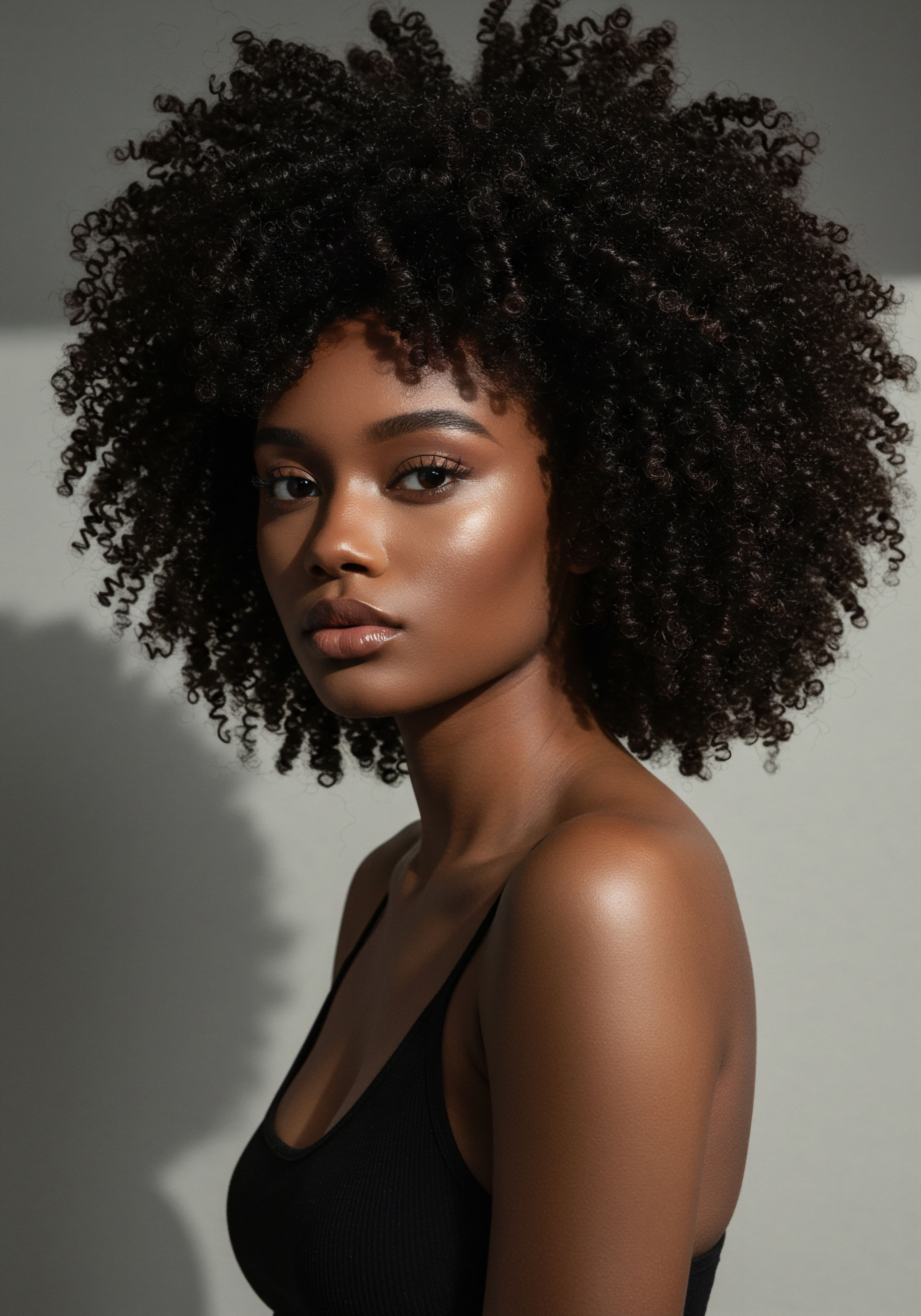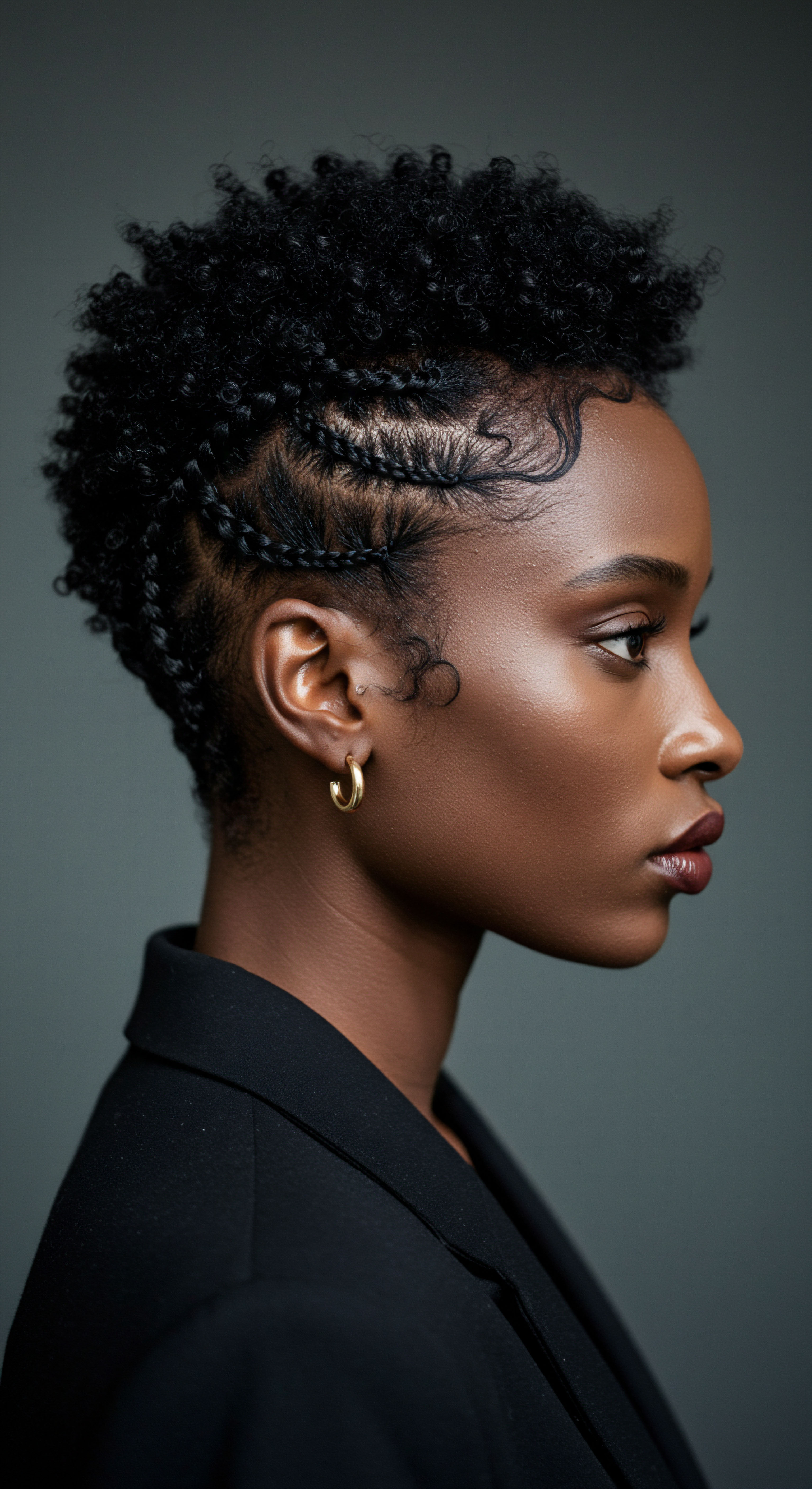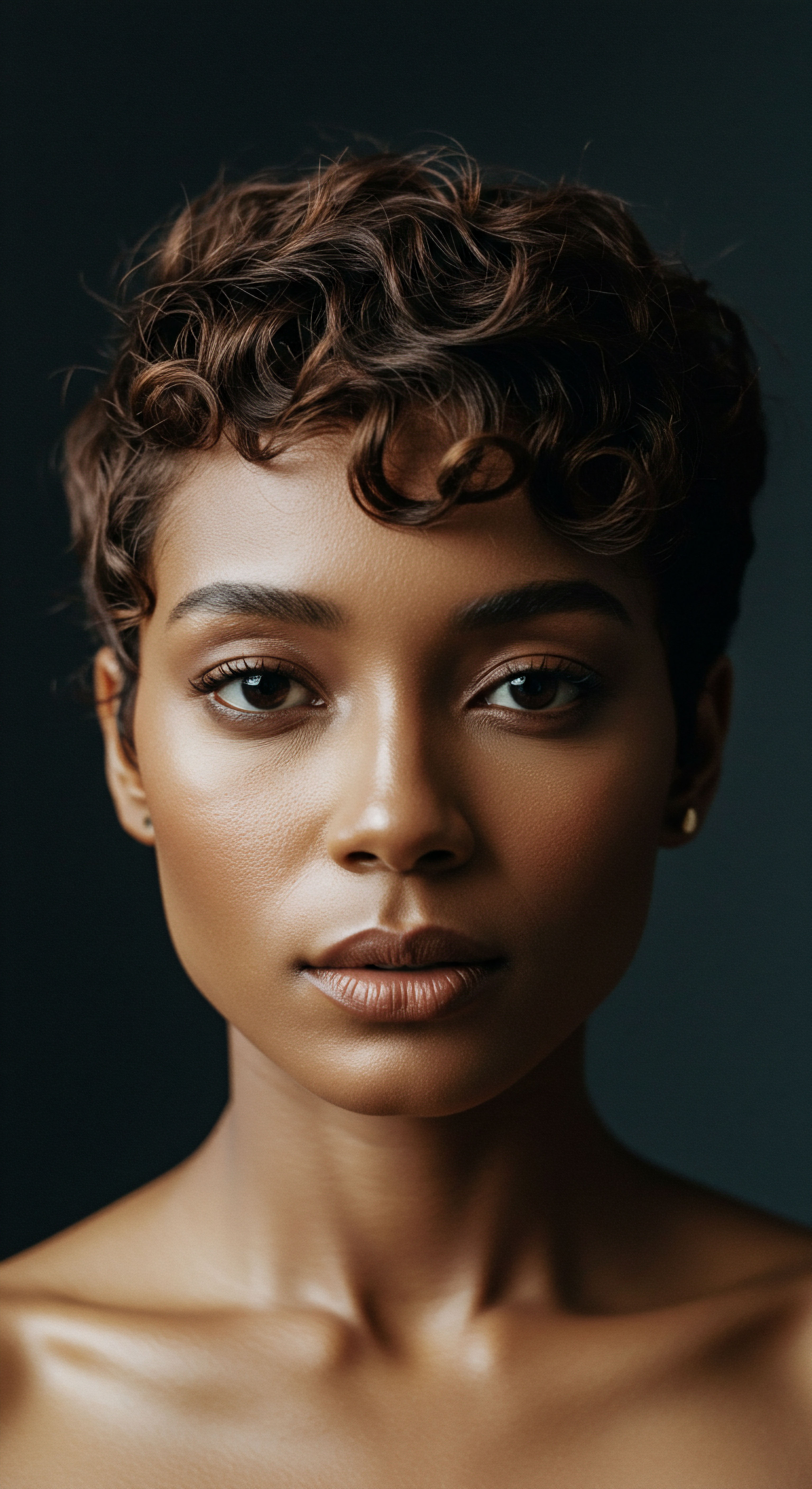
Roots
The story of textured hair, etched across continents and centuries, is not simply a tale of strands and follicles. It speaks of identity, resilience, and the quiet wisdom passed down through generations. To truly grasp modern textured hair wellness, one must first turn to the deep, resonant soil of ancient traditions.
These practices, often dismissed as quaint folklore, hold within them a profound understanding of hair’s inherent nature and its connection to well-being that contemporary approaches are only now beginning to rediscover. We find ourselves at a moment where the scientific lens, focused keenly on cellular structure and chemical composition, starts to converge with ancestral knowledge, revealing a shared reverence for the vitality of our crowns.
Consider the fundamental architecture of textured hair. Unlike its straight counterparts, it dances in spirals, coils, and zig-zags, each curve a testament to its unique protein arrangement and follicular shape. This inherent structure dictates its needs ❉ a thirst for moisture, a propensity for tangling, and a delicate balance that, when honored, allows it to truly flourish. Ancient communities, without the benefit of microscopes or chemical analysis, intuitively understood these characteristics.
Their practices were not random acts, but responses born from intimate observation and a symbiotic relationship with their environment. They knew, through generations of lived experience, what kept these curls vibrant, protected, and strong.

Hair Anatomy and Its Ancient Recognition
The anatomical distinctions of textured hair are subtle yet significant. The follicle, rather than being perfectly round, is typically elliptical or oval, causing the hair shaft to emerge with a natural curve. This curvature creates points of weakness along the strand, making it more susceptible to breakage, particularly when dry. The cuticle layers, which act as the hair’s protective outer shield, often lie less flat in textured hair, contributing to increased porosity and a greater tendency for moisture loss.
Ancient societies, while not articulating these concepts in scientific terms, certainly recognized the outward manifestations. They saw the dry, brittle strands and sought solutions from their natural surroundings.
- Follicle Shape ❉ An oval or elliptical follicle produces hair with a natural curve, predisposing it to coiling.
- Cuticle Layers ❉ These protective scales tend to be raised in textured hair, allowing moisture to escape more readily.
- Breakage Points ❉ The bends and turns along a coily strand create vulnerable areas, requiring gentle handling.

What Foundational Insights from Ancient Hair Care Traditions Persist Today?
The foundational insights from ancient hair care traditions continue to resonate. They recognized the hair’s susceptibility to environmental stressors long before modern science articulated the concept of oxidative damage or UV radiation. Their solutions, derived from plants, oils, and minerals, often served as emollients, humectants, and protective barriers.
The meticulous preparation of these natural ingredients, often involving slow infusions or fermentations, points to an understanding of extraction and potency that predates contemporary cosmetic chemistry. This deep connection to the earth and its offerings formed the bedrock of their hair wellness philosophies.
Ancient traditions intuitively understood the delicate balance of textured hair, recognizing its unique needs through generations of observation.

The Essential Lexicon of Textured Hair Through Time
While modern classification systems like the Andre Walker Type system (1A to 4C) offer a convenient shorthand for describing curl patterns, ancient cultures possessed their own, often more poetic and descriptive, lexicon. These descriptions were not merely about curl tightness; they often encompassed texture, density, luster, and even the way hair moved or felt. Think of the rich vocabulary found in West African languages describing various braids or the specific terms for different hair states in indigenous American cultures. This nuanced language spoke to a deeper appreciation for the hair’s individuality, beyond simple categorizations.
| Ancient Concept "Hair of the forest" |
| Implied Modern Understanding Dense, perhaps coarse, resilient strands |
| Cultural Context Some African tribal dialects |
| Ancient Concept "Water-loving coils" |
| Implied Modern Understanding High porosity, needs moisture |
| Cultural Context Caribbean indigenous practices |
| Ancient Concept "Sky-reaching locks" |
| Implied Modern Understanding Long, strong, spiritual connection |
| Cultural Context Various indigenous cultures globally |
| Ancient Concept These terms reflect a holistic perception of hair, encompassing both its physical characteristics and its symbolic value. |
This historical linguistic richness reminds us that while modern terms offer scientific precision, they sometimes miss the sensory and cultural dimensions of hair. The ancient lexicon invites us to view hair not just as a biological fiber, but as a living part of our being, deserving of respect and personalized care. It speaks to a deep connection that transcends mere cosmetic concern.

Ritual
Stepping from the foundational understanding of textured hair, we now turn to the rhythmic practices that sustained its vitality across millennia. These are the rituals, the deliberate acts of care and adornment that were not merely routines, but sacred dialogues between the individual, their hair, and their community. Modern textured hair wellness, often seeking quick fixes and singular products, can find a quiet revolution in the patient, purposeful rhythms of ancient hair care. This section seeks to unravel how these practices, steeped in intention and connection, offer a profound alternative to the hurried pace of contemporary beauty.
Ancient hair care was inherently holistic. It rarely separated the act of cleansing from the act of nourishing, or the physical care from the spiritual significance. Think of the elaborate braiding ceremonies in many African societies, where the act of styling was a communal affair, a moment of bonding, storytelling, and the transmission of wisdom.
Or the meticulous oiling practices in ancient India, where herbal infusions were applied not just for shine, but for scalp health and mental tranquility. These rituals fostered a deep, intuitive connection with one’s hair, viewing it as an extension of self and spirit, deserving of consistent, gentle attention.

Protective Styling Through the Ages
The concept of protective styling, so vital for modern textured hair, finds its origins in antiquity. Cultures around the globe developed ingenious ways to shield delicate strands from environmental damage, mechanical stress, and the wear of daily life. Braids, twists, cornrows, and various forms of updos were not solely aesthetic choices; they were strategic defenses.
In many ancient African communities, complex braided styles, often adorned with cowrie shells or beads, served practical purposes like keeping hair clean and contained during labor, while also signifying status, age, or marital standing. The longevity of these styles meant less manipulation, allowing hair to retain its length and strength.
Ancient hair rituals offer a profound alternative to modern hurried routines, emphasizing holistic, intentional care.
The efficacy of these protective styles lies in their ability to minimize friction and exposure. When hair is gathered and secured, it is less prone to tangling, snagging on clothing, or suffering damage from harsh winds and sun. This foundational principle remains relevant today.
Modern protective styles, whether box braids, twists, or cornrows, replicate this ancient wisdom, allowing textured hair to rest and grow without constant interference. The shift from daily styling to styles that last for weeks was a quiet revolution in hair preservation.

How do Ancient Styling Methods Mirror Modern Protective Techniques?
Ancient styling methods mirror modern protective techniques in their fundamental goals ❉ reducing manipulation and shielding the hair shaft. For instance, the intricate coiling and pinning seen in ancient Egyptian wigs, or the tightly woven dreadlocks of various indigenous groups, effectively minimized daily stress on the natural hair underneath. These historical practices implicitly understood the delicate nature of textured hair, providing a framework for its long-term health. The materials used, from plant fibers to animal fats, also played a protective role, adding lubrication and sealing moisture.

The Nighttime Sanctuary and Bonnet Wisdom
The nighttime ritual, a cornerstone of modern textured hair care, also possesses deep historical roots. Protecting hair during sleep is not a recent innovation. Ancient Egyptians, for example, used head coverings and elaborate wigs that would have been carefully stored or protected at night.
In many West African traditions, head wraps were worn not only for daytime adornment but also to protect styled hair overnight, preserving its integrity and preventing tangles. This practice of safeguarding the hair while resting demonstrates a consistent awareness of mechanical damage and moisture loss.
The modern bonnet, often made of silk or satin, serves the same purpose ❉ reducing friction against absorbent cotton pillowcases that can strip hair of its moisture and cause frizz. The wisdom behind the bonnet is the wisdom of preservation. It is a simple yet profound act of care, recognizing that even in sleep, our hair needs gentle protection.
- Reduced Friction ❉ Silk or satin creates a smooth surface, minimizing hair breakage from tossing and turning.
- Moisture Retention ❉ The non-absorbent material helps strands hold onto vital hydration, preventing dryness.
- Style Preservation ❉ Keeping hair contained helps extend the life of styles, reducing the need for daily manipulation.

Relay
The journey into ancient hair traditions reveals more than just techniques; it unveils a complex interplay of science, culture, and profound personal meaning. This final exploration delves into the deeper implications of how these historical practices, far from being mere relics, offer a sophisticated lens through which to view modern textured hair wellness. Here, the threads of ancestral knowledge, biological realities, and societal influences converge, painting a richer picture of what it truly means for textured hair to thrive. We move beyond the visible acts of care to the invisible forces that shape our relationship with our hair.
Consider the profound psychological impact of hair. For centuries, hair has been a potent symbol of identity, status, spirituality, and even resistance. In many ancient African societies, hair was a direct conduit to the divine, a spiritual antenna connecting individuals to their ancestors and the cosmos.
The meticulous care, communal styling sessions, and symbolic adornments were not superficial; they were acts that affirmed identity and fostered collective well-being. This stands in stark contrast to the often-individualized, product-driven, and sometimes self-critical experience of modern hair care.

Communal Care and Psychological Wellness
One of the most compelling insights from ancient hair traditions lies in their emphasis on communal care. Hair care was often a shared activity, particularly among women, transforming a solitary task into a powerful social ritual. This communal aspect fostered bonds, allowed for the exchange of knowledge, and provided a space for mutual support. In contrast, the modern textured hair journey can often feel isolating, with individuals navigating a vast, often contradictory, landscape of products and advice alone.
A fascinating case study illustrating this contrast can be seen in the mental health implications of hair practices. While modern media often highlights the negative psychological impact of hair discrimination or the stress of maintaining certain styles for textured hair, ancient traditions often framed hair care as a source of social cohesion and personal empowerment. For instance, a 2018 study published in the Journal of Black Psychology by Dr. Cheryl Tawede Grills and colleagues explored the concept of “African-centered well-being,” noting that communal practices, including hair care, contributed to collective self-esteem and reduced feelings of isolation among participants of African descent.
This suggests that the very act of shared hair care, a staple in many ancient societies, could have served as a protective factor against psychological distress, fostering a sense of belonging and cultural pride that transcends the purely aesthetic. This perspective offers a quiet challenge to the often-individualized, consumerist nature of contemporary beauty standards.

Can Ancient Hair Practices Inform Modern Mental Wellness?
Indeed, ancient hair practices can profoundly inform modern mental wellness. The deliberate slowness, the tactile engagement, and the communal aspect of traditional hair care offered a meditative quality, a grounding presence often absent in our fast-paced world. When we apply a mask with intention, or gently detangle our coils, we can tap into a similar mindfulness. The ancestral emphasis on hair as a symbol of identity and heritage also offers a powerful counter-narrative to beauty standards that might diminish textured hair, instead promoting self-acceptance and pride.

Ingredient Wisdom and Modern Science
The ingredients used in ancient hair traditions were almost exclusively natural, derived from the earth’s bounty. Oils, butters, herbs, and clays were carefully selected for their specific properties. Shea butter, argan oil, various plant extracts, and even certain types of mud were employed for their moisturizing, strengthening, or cleansing abilities. Modern cosmetic science, with its advanced analytical tools, has largely confirmed the efficacy of many of these traditional ingredients.
| Traditional Ingredient Shea Butter |
| Ancient Use Moisturizer, protective barrier |
| Modern Scientific Property Rich in fatty acids (oleic, stearic), vitamins A and E; emollient |
| Traditional Ingredient Argan Oil |
| Ancient Use Shine, softness, scalp health |
| Modern Scientific Property High in vitamin E, antioxidants, linoleic acid; anti-inflammatory |
| Traditional Ingredient Aloe Vera |
| Ancient Use Soothing, hydrating |
| Modern Scientific Property Contains enzymes, minerals, vitamins; humectant, anti-inflammatory |
| Traditional Ingredient Rhassoul Clay |
| Ancient Use Cleansing, detoxifying |
| Modern Scientific Property High in silica, magnesium, potassium; absorbent, gentle cleanser |
| Traditional Ingredient Many ancient ingredients are now staples in modern formulations, their traditional uses validated by contemporary research. |
The “relay” of this knowledge from ancient wisdom to modern science is a testament to the enduring power of natural remedies. However, the ancient approach went beyond simply using an ingredient; it involved a deeper understanding of its preparation, its synergistic effects with other elements, and its application within a ritualistic context. This holistic understanding, where the plant is not just a chemical compound but a part of a larger ecosystem of care, is a valuable lesson for modern wellness.
Communal hair care in ancient societies fostered collective self-esteem, offering a profound counterpoint to modern individualistic beauty standards.

The Interconnectedness of Hair and Identity
The ultimate insight offered by ancient hair traditions is the inseparable bond between hair and identity. For many cultures, hair was a visual language, communicating social standing, marital status, spiritual beliefs, and tribal affiliation. To cut or style hair was often an act imbued with deep meaning, sometimes even a rite of passage. This deep connection contrasts sharply with a modern world where hair can sometimes feel like a superficial concern, a mere aesthetic accessory.
When we consider modern textured hair wellness through this historical lens, we recognize that true wellness extends beyond the physical health of the strands. It encompasses psychological well-being, cultural affirmation, and a sense of connection to a rich heritage. The ancient traditions serve as a powerful reminder that caring for textured hair is not just about product application; it is an act of self-reverence, a connection to ancestry, and a quiet declaration of identity.
- Cultural Connection ❉ Understanding the historical significance of styles and care methods strengthens one’s bond with heritage.
- Mindful Practice ❉ Approaching hair care with intention, as a ritual, fosters a sense of calm and self-awareness.
- Holistic View ❉ Recognizing hair as part of overall well-being, influencing mood and self-perception.

Reflection
The journey through ancient hair traditions ultimately leads us back to ourselves, standing at the crossroads of ancestral wisdom and contemporary understanding. What begins as a simple inquiry into hair wellness blossoms into a profound meditation on identity, community, and our place within a continuum of care. The insights offered by our forebears are not rigid prescriptions, but gentle invitations to reconsider our relationship with our hair.
They beckon us to move beyond superficial concerns, to listen to the whispers of history, and to honor the unique vitality that crowns each of us. The true radiance of textured hair, it seems, has always been rooted in a deeper connection, a knowing embrace of its inherent beauty and the stories it carries.

References
- Grills, Cheryl Tawede, et al. “African-centered well-being ❉ A conceptual framework and preliminary findings.” Journal of Black Psychology, vol. 44, no. 1, 2018, pp. 3-31.
- Fussell, Susan. Hair Story ❉ Untangling the Roots of Black Hair in America. St. Martin’s Press, 2001.
- Byrd, Ayana D. and Lori L. Tharps. Hair Story ❉ Untangling the Roots of Black Hair in America. St. Martin’s Press, 2014. (Updated Edition)
- Blume, Hillary. Gods, Hair, and the Human Body ❉ A Cultural History of Hair. New York University Press, 2017.
- Hope, S. J. Hair and Hair Care ❉ An Anthropological Perspective. Routledge, 2019.
- Pitchford, Nicole. Afro-textured Hair ❉ A Guide to Professional Care and Styling. Milady, 2021.
- Jackson, Elizabeth. The Science of Hair ❉ A Comprehensive Guide. Cambridge University Press, 2020.